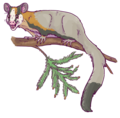Indotriconodon magnus is an extinct mammal from the Late Cretaceous of India. A eutriconodont, it represents the geologically youngest of the group dating to the Maastrichtian just a few thousand years before the KT event (a record previously held by Alticonodon lindoei from the Campanian of Canada), as well as a relatively large sized Mesozoic mammal.[1]
Description
Indotriconodon magnus is known only from a single lower molar. It is about 20% smaller than that of Repenomamus giganticus but larger than that of other eutriconodonts, making it a badger-sized mammal.[1]
Phylogeny
In its 2024 description it nests deeply within Eutriconodonta, being sister taxa to Volaticotherini.[1]
Palaeoceology
Found in the Intertrappean Beds, it co-existed with at least other ten mammal genera as well various squamates, turtles and dinosaurs.[1] In this time, India was isolated from other landmasses, and had a unique island biota.
References
- ^ a b c d Bajpai, Sunil; Rautela, Abhay; Yadav, Ravi; Wilson Mantilla, Gregory P. (2024-02-29). "The first eutriconodontan mammal from the Cretaceous (Maastrichtian) of India". Journal of Vertebrate Paleontology. doi:10.1080/02724634.2024.2312234. ISSN 0272-4634.














